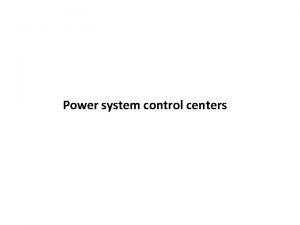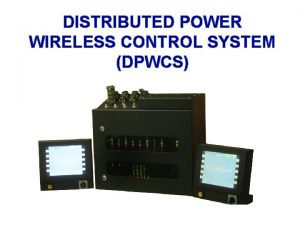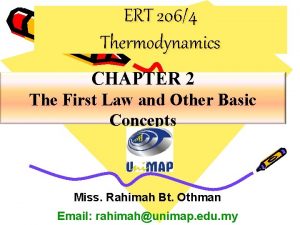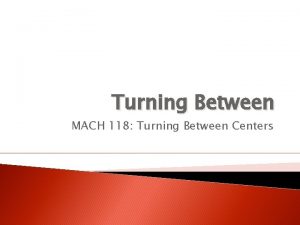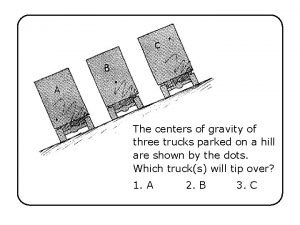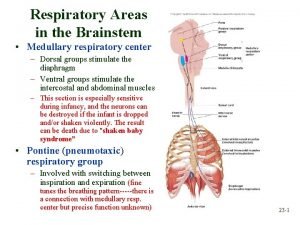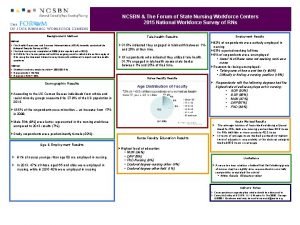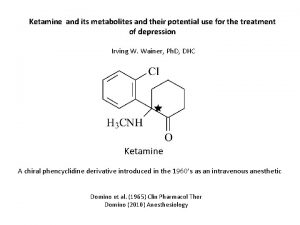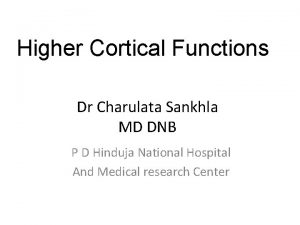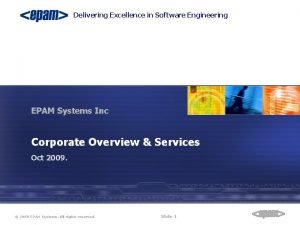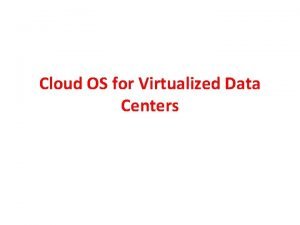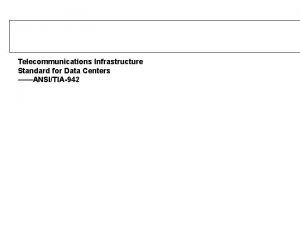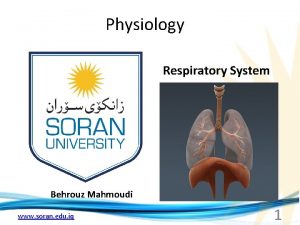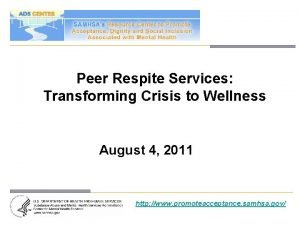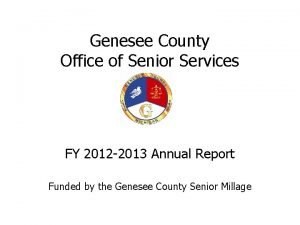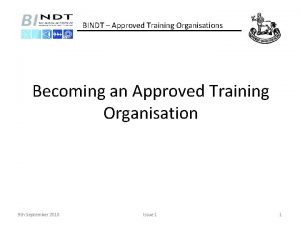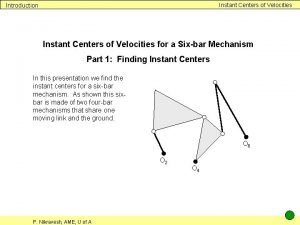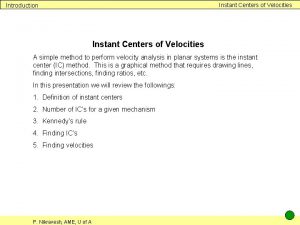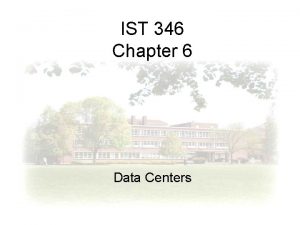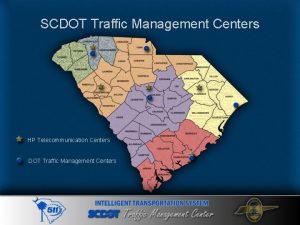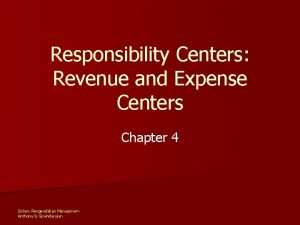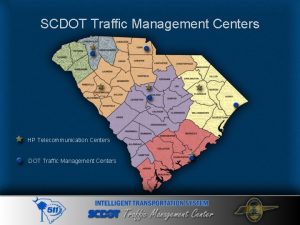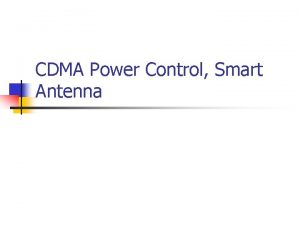Power system control centers Aim of control centers










































- Slides: 42

Power system control centers

Aim of control centers: • Set up at appropriate locations to dispatch and control functions to ensure quality and continuity of power supply to the consumer at an reasonable cost. • Major control centers posses SCADA systems • The objective function includes supervision of state of elements like generators, transformers, transmission lines. • Responsibility of the control center is to ensure the security of the elements in the system and to assess the system security. • It ensure economic operation and display the instantaneous state of the system. • Restore the normal functioning of the power line.

• Role of central control centre(CCC) : network management and decision making. • Role of regional control centre(RCC): implementation of CCC directive and control of HV transmission and sub transmission network directly. • Controls captive power generation. • Responsible for directing LCC as per the guidelines of CCC and to govern the distribution network. Role of localcontrol centre(LCC): • To control generation as per directives and also has control on sub transmission network.

• Planning objective: • To control a power system properly , it is very much essential to plan the system operation with proper scheduling objectives. • The scheduling may include short term as well as long term scheduling. • In short term scheduling the program may be for hourly interval for 24 hr period. • For long term scheduling the schedule of interval is for months or on a weekly basis. • The main aim of scheduling is to find optimal mix in hydro thermal generation and to decide upon the exchanges with the neighboring systems.

• The planning objective includes • (i) selection of generating units to serve the normal load demand to serve during emergency. • (ii) anticipated load demand. • (iii) power system network structure to cope with the demand available generation. • (iv) evaluation of possible contingencies and schemes. Functions of control centres: (i) planning (ii) Monitoring of the interconnected system (iii) Data acquisition and system control.

• Planning: • Most important planning aspect is load forecasting and generation scheduling. • Short term load forecasting is preferred when the forecasting is done on a daily basis. • Forecasting ensures the prediction of the load curves as accurately as possible with reference to the load curves of the previous day, the corresponding day in the previous week and year and also taking into account weather conditions. • In some forecasting programs the skill of operator (or) experience is included, but usually load forecasting is attempted following automatic computer algorithms based on extrapolation methods. • Implementation of forecasting programs based on artificial neural networks (ANN) is more effective and takes into account the role of weather, labour problem, disputes and contingencies.

• The next planning aspect is to determine the power reserve in the system • A certain amount of power reserve is usually maintained in interconnected system in excess of load demand in order to provide the scope for maintenance of units and to have some spare capacity to meet minor contingencies. • Power reserve also covers the errors in the estimation of the load demands. • The capacity of the reserve depends on the number and size of the generating units, maintenance requirements, characteristics of plants, security aspect , load level, seasonal factors. • Plant scheduling and unit commitment are also very important aspects , usually scheduling is done that major hydro and thermal plants serve as base load plants.

• Base load plants operate for full time while the peak load plants are preferred into service for the required intervals of time. • Maintenance of line loadability is also an important aspect of planning in control centers. • The control center should plan the routing of power flow through designated lines in order to avoid overloading. • In proper system planning, the role of reactive power is very important. • Proper reactive power flow can only maintain the voltage level at different load bus within specified values. • Proper reactive power scheduling should also include adequate security margins. • During light load condition the system encounters reactive power surplus and the long lines may suffer from Ferranti effect. Shunt reactors are to be pressed into the service to control the voltage at the remote ends of the lines.

• During heavy load period, the system voltage drops and it needs to inject capacitive reactive power into the system, Capacitive reactive compensators are then pressed into the service. • Monitoring: • In a planned operation the difference between anticipated load curve and the actual load curve is marginally small and even if it is there usually covered by the spinning reserve. • The objective of the monitoring is to ensure that despite the fact that the power system condition deviates from time to time with respective to the scheduled scheme. • Load generation balance is maintained with respect to both active power and reactive power and the voltage levels at respective bus are maintained within limits and the line flows are not exceeded. • If by following sudden contingency the system may go beyond control and the control centre should have pre-drawn plans to

encounter such urgencies and restore power system from vulnerable collapse. To perform the above task the control centre should have the following facilities: (i) The active and reactive power demands at the load buses and available generation. (ii) The system frequency. (iii) The volume of power exchange. (iv) The exact configuration of power network (v) The breaker status at substations. All the above data is picked up at regional load dispatch centers and telemeter to the central control station and updated at short time intervals. this provides almost an instantaneous picture of the network condition.

• The control computer receives all this data and check their validity using state estimation algorithm and displays the information the operator. • The displays are both visual , high speed printers and curve plotters. • The control center data thus helps in real time assessment of the power system. • Data acquisition and system control: • Data acquisition subsystem consists of remote terminal equipment for interfacing with power system instrumentation and control devices. • It also interfaces with communication channels and master station equipment. • The data is scanned at regular intervals( in every alternate second).

• A developed data acquisition software is installed for processing the data and displaying the placing them in memory, error and limit checking and interfacing. • The control aspect mainly includes the system frequency and voltage control. • Power exchange control may be an additional task of the control centre. • In small interconnected systems, the control is performed by a number of stations. • The control programs include the criteria of economic operation too and perform effectively in controlling the schedule of generation.

set up: • In earlier days of power system, the interconnected network was simple with a few load centers, fewer generating source, connected by short or medium long transmission lines. • As the system developed and became more and more complex, the dispatching control system acquired a two or three tier structure. • The control objectives are now distributed between the tiers. Where one tier or stage serves as a back up to another for a particular function. • The functions are as under: • (i) data acquisition and recording • (ii) remote control of breaker status • (iii)load scheduling and economic operation • (iv) automatic generation control and load frequency control.

• (iv) state estimation and security monitoring. • (vi) emergency control. • In modern control centers three tier system being implemented. • The first tier serves as the system dispatching center. • The second as the regional load dispatching center and the third tier as the remote control center. • the functions that system dispatching centre serves are as follows. • • (i) data acquisition of the state of the network. (ii) data recording (iii)load frequency and automatic generation control(AGC). (IV) economic operation, state estimation and security assessment.

• The second tier ( regional control center) only collects and stores the data from the system, while third tier ( remote control centre) controls the breaker status under normal operating conditions. • The system also equipped with emergency control like load shedding etc. in case of contingencies. • The first tier usually controls the whole transmission network and the second tier usually serves as back up of the first tier, particularly for the purpose of data acquisition. LOCATIONS: Location of a control center is very important. It must be located at an appropriate site and must be equipped with the necessary facilities for data acquisition and control.

• Communication with all the predetermined sections of the network is an important aspect for selecting the location of a control center. • The reliable communication system is a vital component of system operation, the location of the center must take into account this aspect. • The location of the control center is not governed by either its desired proximity to generating station, substation or load center, or to act as the center of gravity of loads or generation. • the location of control center is based on the following broad principles: • (i) it should be close to the hub central communication facility of the area and should have a number of leased/ hired channels of communication at its disposal.

• (ii) it should be close to the points in the network such that power line carrier communication (PLCC) facilities are available. • Very often these facilities are provided in big load centers. • (iii) the load dispatch center should be well connected by rail and road. • (iv) since the load dispatch center is the hub of activity of power operations, the key personnel must be available close to the load dispatch centers. Central facilities: The central facilities to be provided at a load dispatch center are (i) A telephone exchange. (ii) A mainframe computer system with suitable number of terminals, a number of PCs must be available.

(iii) a display board (iv) telemetry equipment. (v) control equipment. (vi) batteries (vii) UPS (viii) a central air-conditioning /heating plant. in addition to the above central facilities, other facilities include (i) tele printer facilities (ii) weather information facilities (iii) a diesel generator set. (iv) fire fighting system (v) a workshop for in house maintenance of equipment against minor problems. • (vi) slide projectors and power point projections • (vii) good illumination. • • •

CIVIL FACILITIES: The civil facilities include (i) Housing of all equipment. (ii) Proper sitting arrangements for engineers and staff (iii) Proper water facility (iv) Refrigerated food and water storage facilities (v) Mostly sound proof enclosures (vi) Smooth sound proof flooring (vii) Proper building protection against lighting (viii) Immunity to floods and other natural calamities upto a certain extent. (ix) A good canteen (x) A first aid center (xi) An ambulance (xii) Necessary security personnel

Facilities in control room: • Control room should have the control desk, instrument consoles and a mimic diagram. • Control desk should be equipped with CRT displays, meters, recorders, annunciation panels with colored displays of the annunciation window and intercom facility. • The control desk is used by the operator to monitor and/or control system frequency and voltage, load level, generation level and intersystem load transfer. • The instruments in the control desk give different information about the system. • The annunciation panels provide the state of equipment and/or in case of emergency the annunciating window either blinks with alarm sound or gives a red colored indication. • Alarms can be acknowledged by pressing the appropriate alarm buttons.

• The mimic diagram is basically an indicator of the power network in the form of a single line diagram. • Alpha numeric display units (VDU) are mostly in use for indication, metering and alarm display in addition to the mimic board. • The mimic board gives an overall pictorial view of the entire system with breaker status. • It gives the operator an immediate indication about the state of the power network. • The mimic board is also provided with various instruments like frequency meter, system demand at strategic locations, voltage levels at different buses and lines, system demand, inter system MW transfer etc. • Lamp indicators are provided to depict the status of circuit breakers • Special types of signals/lights may be used to identify overloads.

• The control system comprises a computer system. The computer system usually is a duplex system- the first one being the online master computer while the other is a standby. • By use of proper hardware incoming data is continuously entered in both the systems automatically. Both the computer systems are identical and connected in such a way so that the peripheral devices of one system suits with the other. • The computer may help to display the entire network and telemetered data at strategic points of the network such as power flow, breaker status etc. • All the information may get stored and arrangements can be made to reproduce the past information, and other facilities in the control centers are auxiliary and back up power supply, air conditioning system.

• For proper funct ioning of the control center the equipment are needed: • (i) DC battery system • (ii)harmonic free stabilised AC supply. • (iii) UPS with auto changeover facility. • (iv) diesel generator set • (v)heating, ventilation and air conditioning system.

COMMUNICATION: • A load dispatch can perform communicate with generating centres, sub stations etc reliably and accurately with utmost speed. • There are number of existing communication techniques used for effective communication of the load centers, power line carrier communication (PLCC), leased telephone lines, microwave channels, fibre optic channels and satellite communication. • The choice of any particular communication technique depends on various factors, including the capacity and quality, data diversity and economic aspects.

• Power line carrier communication (PLCC): • PLCC is frequently used for communication over medium and long distance power transmission networks. • It is very economical and reliable method of communication. • Telephonic and data communication system data hardware's operate at low DC voltage, it cannot be directly connected to the HV or EHV power line, suitable coupling devices are used for this purpose. • Radio frequency data/voice are prevented to enter the substation bus and are directed towards the carrier equipment. • The power frequency voltage or current is allowed to enter the station bus while they are prevented to enter the carrier equipment. • Wave trap and coupling capacitor are employed to achieve these objectives.

• In PLCC communication, the carrier wave is generally transmitted with two side bands. • This enables the use of very simple equipment but offers broad band transmission facility. • Usually , the carrier frequencies are in the range of 50 -300 hz while the audio bandwidth of PLCC is 200 -3400 hz. This includes the bandwidth for data transmission in the range of 2000 -3400 hz. • The characteristic impedance of a long transmission power line being around 400 ohms , the signal attenuation is in the order of 0. 1 d. B per km for a 220 k. V line. • The signal frequency selection is largely governed by the condition that PLCC signal should not interface with radio broadcasting or telephone systems. • Both very low and very high frequencies are not recommended as very low frequency will increase the size of coupling capacitor, while very high frequency will increase radiation loss and may create interference with other communication channels.

• Noise in high voltage lines is created due to corona discharge and may affect signal/noise ratio. • Necessary electronic hardware's are designed to be installed to maintain proper signal/noise ratio for PLCC applications in HV systems. • PLCC is very much suitable for application in case of lines connecting two ends only. • The PLCC application faces difficulty when the line has tee-offs • Another problem of PLCC is that its performance gets affected during rain or snow. Leased telephone lines: • Telephonic circuits can be leased by the power utility from the telecom agencies under some financial contracts. • The advantage of such a leased circuit include the simplicity and ease for power utility to acquire a dedicated communication channel. • Thus the need for land, building, manpower, investment etc are eliminated in case a power utility hires a leased circuit.

• The leased telephone channel comprises telecommunication channels, overhead lines and radio frequency links. • The bandwidth of these hired circuits is low (in the order of 300 -400 hz) though the circuit is fully dedicated. • All types of voice and data transmission are possible and signal/noise ration is good. • The power consumption is low and the bandwidth usually includes data transmission channel in addition to voice telephony. • The disadvantage is that breakdown of hardware in telephone exchange or link failure may disrupt the communication till it is repaired.

• MICRO WAVE CHANNEL: • micro wave channel in power system communication between control centers and generating stations/sub station is very reliable, the bandwidth is also very large. • Multiplexing system can be used for data transmission and the voice channels remain independent of telemetering and data transmission channels. • The power transmitted is even lower than PLCC but signal/noise is higher with higher bandwidth. • Microwave links have usually parabolic antennas. • These antennas focus the energy into a narrow beam directed towards the receivers. • Use of repeaters is very common in micro wave links to remove the problem of fading. • Repeater stations are installed so as to keep the microwave free from shading.

• The micro wave terminals are usually located at substations and power plants and the repeater is located in the next station. • The micro wave links have some specific advantages like low maintenance, economic operation, feasibility of adding more channels at low cost and independent transmission line trip problem. • However microwave links have few disadvantages too, they need a number of repeater stations, minor fading effect and installation of antennas.

• Fibre optic communication: • In fibre optic communication light is used as a carrier. • In fibre optic channel cross section of the cable is cylindrical structure and has a central region, called the core. • There is a surrounding external cylinder around the core and is named as cladding. • The refractive index of cladding is less than the core. • Once a light ray is incident at interface between the core and cladding at an incident angle greater than the critical angle, the ray suffers total internal reflection and it then propagates along the fibre through a series of successive total reflection. • In all fibre optic communication channels, the main components are (i) an optical source • (ii) a hardware to modulate the light with the signal to be transmitted

• (iii) optical fibre medium • (iv) an element that converts the received light back into electrical signal • (v) amplification and signal processing hardware to recover the original signal and reproduce it at the receiving end. • Optic fibres are made up of silica, they are transparent. • The core is usually doped with germanium with phosphorous pentoxide in order to increase the refractive index. • In case of long path transmission of optical signal, there may be fading and a repeater may then be needed to boost and regenerate the signal. • In fibre optic cables the bandwidth is very latge, enables greater information to be carried. • It can be used both for telecommunication and data transmission by the utility. • Fibre optic communication not only for inter station or inter center communication but also for in house communication.

• It can also be used in HVDC terminal stations. • Fibre optic channels possess the promise for the power utilities because of their high channel capacity and total immunity to electromagnetic interference. • Fibre optic channels have high data security and very low transmission error rates. Satellite communication channel: • Satellite can be used to offer communication between two stations ( load dispatch center and a power station/sub station). • The satellite is located at geostationary orbit above the equator. • At this distance the satellite orbits around the earth once in 24 hours and appears stationary with reference to a particular place on a earth, the satellite acts as a repeater at this place.

• In satellite communication, the modulated signal is sent from the transmitter on earths surface on a uplink frequency in 6 Ghz band to the satellite. • The function of the satellite is to regulate the signal and return it to the earth. • The receiver on earth catches this signal by means of parabolic or spherical dish antennas which are precisely aligned to face the satellite. • India has INSAT-II series of communication satellite. • Satellite communication, the frequencies are devided into a number of 36 Mhz transponders. • There are number of transponders and the transmitted signal occupies one of these transponders. • Multiple number of stations/centers can share a transponder, there may be two different aspects of sharing the capacity of a satellite. • The first one is called multiplexing and it involves the same schemes of frequency and time division multiplexing. • in second one, satellite is shared with many antennas.

• In recent times very small aperture terminal (VSAT) is extensively used for satellite communication with a central station. • The dish diameter is low and hence the name very small aperture. • VSAT consists of a transreceiver, a modem and a controller. • VSAT communication is done from the satellite to a hub in the earth, hub controls and monitors the function of a number of VSATs. • Satellite communication is very modern and reliable with high degree of accuracy but it suffers from the problem of radio interference, a small delay in transmission and non operation of the satellite when the shadow of the earth comes over it. • When sun passes directly behind the satellite, the transmission from the satellite consists of noises, and the satellite transmission is costlier.

EMERGENCY CONTROL: • It is a closed loop control automatically actuates load shedding(or generation reduction) in order to cope with overloads or under loads to restore generation load balance. • The main purpose of emergency control is to relieve overloads in transmission lines and transformers and to ensure that throughout the system the generation is equal to the sum of load and loss. • Emergency control prevent disruption of normal grid operation and deterioration of quality of power supply. • The emergency control may be automatic or manual on the assessment of the situation by the operator. • Emergency control may be needed when the system frequency declines in a system because of tripping of transmission lines or generators. • In case of sudden reactive power deficits like tripping of compensators or generators, emergency control is also needed.

• Normally frequency variation upto ± 0. 5 % may be tolerated before any emergency control is actuated. • On the basis of the same concept. A voltage change of ± 3% in the transmission sector and ± 5% in the sub transmission sector may be tolerated. • Once the system frequency declines beyond ± 0. 5% hydro plants are pressed into service to give their peak output and pumped storage plants may be started. • In case frequency overshoot beyond 0. 5%, hydro plants may be asked to reduce generation. • In case frequency fall is beyond 0. 1% automatic start up of quick start generator(gas turbine) is initiated. • Beyond a frequency decline of 0. 3%, load shedding is restored. • Usually the amount of load to be shed is 10% of the peak demand. • With further decline, the magnitude of load to be shed may be increased to 15% or higher.

• For accelerated load shedding in a graded load shedding, scheme rate of frequency change relays(df/dt) may be utilised. • Still the (df/dt) value is not very high, load shedding can be continued. • These relays are used to actuate the stage by stage load shedding and to isolate an healthy system from an affected system in case of sharp frequency decline in a short span of time. • Inadvertent operation of such a relay may create problem of unwanted load shedding. • Hence the maximum of load which can be connected to any (df/dt) relay is generally limited to a specific value. • For any (df/dt) relay operation, operator inspection is a must.

• For effective emergency control, the following points are usually adopted. • (i) load shedding is usually spread throughout the system. • (ii) load shedding is initiated in steps. • (iii) attempts are to be made at regular intervals to restore the system once the corrective measures are taken. • (iv) load shedding is automatically carried out by present relays and is a function of frequency and time. • The main role of df/dt being the detection of rate of decline of frequency, its another aim should be helping the operator indirectly to restore loads and bring the system normal state. • The best way to maintain system voltage is to keep primary regulation low. • In addition to this, the reactive power compensators are installed at strategic locations in the network.

• In case the receiving end voltages decline further, it is recommended to shed some major loads at receiving end. • Secondary regulation is adopted in some systems, at location of some strategic nodes in the network. • This strategic nodes acts as representative of the surrounding network. • The actual voltage at strategic node is measured and compared to the scheduled value. • The difference is used to initiate the voltage regulator that will correct the voltage to nominal value at strategic location. • Once the system blackout occurs , the restoration procedure should start. • In most of the developing countries, the restoration is mostly based on experience of the operators and engineers and fully guided by circumstances and human skill. • Now a days attempts are being made to implement the restoration procedure through computerized schemes due to vastness of the network.

• When power system gets separated from the generating units, the various breakers normally remain in the closed or in open position as they were before blackout. • Thus , it is dangerous to attempt re energisation of the network as a whole simultaneously. • The restoration should start through pre drawn restoration routes, only breaker in the restoration route may be in a close d position other breakers should be in open position. • On successful restoration of one route , the next route should be attempted. • Supervision of synchronization and restoration of the routes must be ensured. generation is to be adjusted so that frequency and voltage remains within prescribed limits following restoration of routes.

• Proper feedback is also necessary to guide the dispatcher for restarting of the generator and to apply load of the restored route gradually. • The first attempt is restoration of the network and then reconstituting the larger part of the network.
 Power triangle
Power triangle Power angle curve in power system stability
Power angle curve in power system stability Power system control center
Power system control center Wireless control system
Wireless control system Solar power satellites and microwave power transmission
Solar power satellites and microwave power transmission Potential power
Potential power Flex28024a
Flex28024a Dispersive power of grating is inversely proportional
Dispersive power of grating is inversely proportional Power of a power property
Power of a power property General power rule
General power rule Power bi power point
Power bi power point Power delivered vs power absorbed
Power delivered vs power absorbed Control mass in thermodynamics
Control mass in thermodynamics Turning between centres
Turning between centres Maricopa juvenile detention center
Maricopa juvenile detention center The centers of gravity of the three trucks
The centers of gravity of the three trucks Medullary center
Medullary center National forum of state nursing workforce centers
National forum of state nursing workforce centers Nccpa pance registration
Nccpa pance registration Microsoft technology centers
Microsoft technology centers Ketamine chiral centers
Ketamine chiral centers Dr charulata sankhla review
Dr charulata sankhla review Unique data centers
Unique data centers Neer classification proximal humerus
Neer classification proximal humerus Epam upsa
Epam upsa National consortium of interpreter education centers
National consortium of interpreter education centers Trust management in virtualized data centers
Trust management in virtualized data centers Granite reef senior center
Granite reef senior center Propivacaine
Propivacaine Chiral and achiral meaning
Chiral and achiral meaning Atlas ossification centers
Atlas ossification centers Unstructured cabling
Unstructured cabling Respiratory centers
Respiratory centers Peer respite centers
Peer respite centers Regional centers for workforce transformation
Regional centers for workforce transformation Nih institutes and centers
Nih institutes and centers Jellyfish networking data centers randomly
Jellyfish networking data centers randomly Universities that accept ged in pakistan
Universities that accept ged in pakistan Global marketplaces and business centers
Global marketplaces and business centers Genesee county office of senior services
Genesee county office of senior services Bindt training
Bindt training Channel home centers v. grossman
Channel home centers v. grossman New centers of civilization
New centers of civilization


